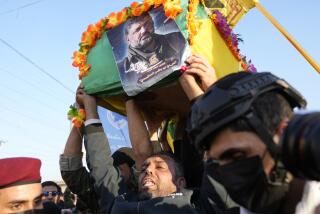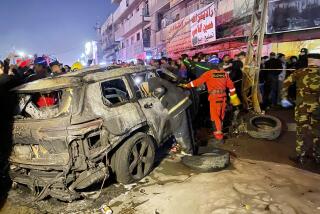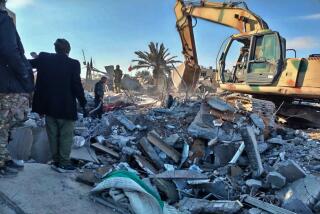Iraq army wields a double-edged sword in enlisting Shiite militias
Signs and banners drape the fences and electricity poles of Baghdad in a tapestry of religiously iconographic red, black, yellow and green. Most depict young Shiite Muslim men, replete with military uniforms, stern expressions and slogans extolling the bravery of the fallen.
“They are on the path of victory!” declares one poster. “Whoever possesses the spirit of martyrdom is undefeatable,” promises another.
The placards function as pictorial obituary and recruitment drive, not for the Iraqi army, but for a dizzying array of Shiite-dominated paramilitary groups, known collectively as Hashd al-Shaabi, or Popular Mobilization, that augment government forces in the fight to reclaim large swaths of the nation seized by the largely Sunni militants of Islamic State.
The Popular Mobilization has become the backbone of that campaign, with an estimated 20,000 Shiite militiamen leading the current offensive in Salahuddin province. On Wednesday, a top Iraqi official declared victory in the provincial capital, Tikrit, which had been overrun by Islamic State in June.
The militia members, however, remain a source of unease and largely unproven promise: Many Iraqis fear that the presence of Shiite fighters in largely Sunni areas will bring a return to sectarian violence that nearly tore Iraq asunder a decade ago. Yet Popular Mobilization leaders point to the presence of several thousand Sunni fighters among their forces as a sign that conflicts of the past can be avoided while fighting a common enemy.
The Popular Mobilization rose out of the collapse of the Iraqi military when Islamic State fighters swept out of Syria and seized control in much of northern and western Iraq. Faced with that failure, the Shiite-led government in Baghdad issued a call to arms backed by the country’s most senior Shiite cleric, Grand Ayatollah Ali Sistani, who ordered citizens “able to bear arms and fight terrorists” to “volunteer and join the security forces to achieve this holy purpose.”
Thousands of young Iraqis streamed into recruitment offices in Baghdad and southern provinces. Established Shiite factions such as the Badr Organization and the League of the Righteous joined wholesale, while other groups sponsored and created their own ad hoc armed units, sending many into the fray with little military training.
That created a new set of headaches for the government, Popular Mobilization spokesman Karim Nouri said.
“Not all who heeded the call of [Sistani] were able to bear arms and fight, but some people wanted the salaries and the rights given to the fighters,” he said in an interview at his home on a quiet Baghdad street. “This embarrassed us, so we formed the Popular Mobilization committee a month later to crystallize matters and organize them.”
Nouri said 30,000 fighters operate in an unofficial capacity in addition to 60,000 government-registered militiamen. The registered fighters receive about $700 a month from the government, of which about $100 serves as a food allowance on the front. Families of the fallen receive compensation.
“The salary for a U.S. soldier is equal to that of 10 Iraqi fighters, but every Iraqi fighter is worth 10 U.S. soldiers,” Nouri said.
The committee is attempting to coordinate the efforts of the militiamen.
“In the past, training was up to each individual group, but now there are institutions for training, for planning, logistics and supplies,” said Ali Yaaseri, head of the Khorasani Brigades, another Shiite faction based in Baghdad. “There are also plans to build hospitals exclusively for the wounded from the Popular Mobilization for medical treatment so as not to crowd civilian clinics.”
Support on the battlefield also comes from as many as 60 advisors from Iran and the Lebanon-based Shiite militant group Hezbollah, Nouri said.
Popular Mobilization officials seek to allay fear of the return of sectarian violence, noting that Sunnis are fighting in the north alongside Shiite militias.
“I believe that sectarianism ended in the battle of Salahuddin,” said Naeem Aboudi, spokesman for the League of the Righteous. “In general, there are 3,000 [to] 4,000 Sunni fighters distributed among the different groups of the Popular Mobilization.”
Government officials have demanded that fighters show restraint in dealing with civilians. Sistani in February issued a list of instructions, supported by religious texts, on how fighters should behave on the battlefield.
Some analysts also worry that fighting will eventually break out among the Shiite militias, as has occurred among factions battling to overthrow Syrian President Bashar Assad.
“Most of the brigades have their own satellite channels and some of them claim achievements that are not their own,” security affairs researcher Hisham Hashimi wrote on his Facebook page on March 19.
Hashimi, based in Baghdad, believes this “has drawn [their] followers … into clashes along with the presence of the factors of ignorance, excitement and psychological pressures for most of them.”
On a recent tour organized by the Badr Organization near Tikrit, a convoy of visiting journalists observed twitchy militiamen from ostensibly allied factions nearly get into a firefight when their cars were not allowed to pass.
With tempers flaring on both sides, one fighter pointed his rifle at the feet of the official in charge and fired off a volley. Gunmen rushed to the source of the commotion, but the commanders, fearing a scandal, screamed at their cadres to calm down.
Yaaseri, the head of the Khorasani Brigades, says conflicts may happen among fighters but not among the leaders, who act in concert.
Nevertheless, it does not bode well for the future if the Popular Mobilization is disbanded and its cadres integrated into something akin to a national guard, one proposal being considered.
“Just because my brother and I fight together does not mean we have the same direction,” said Rahman Jazaaeri, head of Hezbollah al Thaaeroon, a small party “inspired by the success” of Lebanon’s Hezbollah. “Our thoughts today are different from our brothers in the Badr Organization and the Sadrists [another movement]. We are an Islamic resistance with a political and social dimension as well.”
Yaaseri also wonders why his group should eventually integrate into a heretofore ineffectual government security force.
“If they do their duties, then I’m willing to be a part of them; but as long as I’m better, with better performance and more sacrifice, then they should join me,” he said. “And this has already happened, when army and police members resign and join our group because they felt they could do more with us.”
In a recent sermon Sistani said, “All parties participating in the battles should unify under the flag of Iraq and not fly their own banners so as not to cause fear and panic.”
Popular Mobilization spokesman Nouri agreed that there were issues melding the Shiite militias.
“We don’t want the sacrifices of one group to be taken by another group, like the Saraya al-Salam,” he said, referring to the Peace Brigades of radical Shiite cleric Muqtada Sadr. The cleric’s fighters rejoined the offensive beside their coreligionists after taking a two-month break because of concern about sectarian-fueled violence.
Nouri explained that other groups have refused to accept the Sadrists’ return to the Tikrit front, and that the group should be restricted to a support role.
“This will certainly affect Sadr’s political future,” Nouri said, “because the Iraqi people now appreciate those who fight for them.”
“Besides,” he said with a quick smile, “there is no shame in investing our victories for a political goal.”
Bulos is a special correspondent.
More to Read
Start your day right
Sign up for Essential California for news, features and recommendations from the L.A. Times and beyond in your inbox six days a week.
You may occasionally receive promotional content from the Los Angeles Times.







